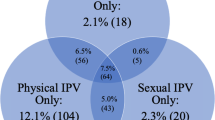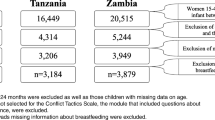Abstract
The study assessed the relationship between postpartum intimate partner violence (IPV) and postpartum health risks among young mothers over time. Data were collected from 2001 to 2005 on young women aged 14–25 attending obstetrics and gynecology clinics in two US cities. Postpartum IPV (i.e., emotional, physical, sexual) was assessed at 6 and 12 months after childbirth (n = 734). Four types of postpartum IPV patterns were examined: emerged IPV, dissipated IPV, repeated IPV, and no IPV. Emerged IPV occurred at 12 months postpartum, not 6 months postpartum. Dissipated IPV occurred at 6 months postpartum, not 12 months postpartum. Repeated IPV was reported at 6 months and 12 months postpartum. Postpartum health risks studied at both time points were perceived stress, depression, fear of condom negotiation, condom use, infant sleeping problems, and parental stress. Repeated measures analysis of covariance was used. The proportion of young mothers reporting IPV after childbirth increased from 17.9 % at 6 months postpartum to 25.3 % at 12 months postpartum (P < 0.001). Emerged and/or repeated postpartum IPV were associated with increased perceived stress, depression, fear of condom negotiation, and infant sleeping problems as well as decreased condom use (P < 0.05). Dissipated postpartum IPV was associated with decreased depression (P < 0.05). IPV screening and prevention programs for young mothers may reduce health risks observed in this group during the postpartum period.


Similar content being viewed by others
References
Kingston, D., Heaman, M., Fell, D., et al. (2012). Comparison of adolescent, young adult, and adult women’s maternity experiences and practices. Pediatrics, 129, e1228–e1237.
Abramsky, T., Watts, C. H., Garcia-Moreno, C., et al. (2011). What factors are associated with recent intimate partner violence? Findings from the WHO multi-country study on women’s health and domestic violence. BMC Public Health, 11, 109.
Catalano, S. (2007). Intimate partner violence in the United States. Washington, DC: U.S. Department of Justice, Bureau of Justice Statistics. http://www.bjs.gov/content/pub/pdf/ipvus.pdf.
Bailey, B. A. (2010). Partner violence during pregnancy: Prevalence, effects, screening, and management. International Journal of Women’s Health, 2, 183.
Harrykissoon, S., Rickert, V., & Wiemann, C. (2002). Prevalence and patterns of intimate partner violence among adolescent mothers during the postpartum period. Archives of Pediatrics and Adolescent Medicine, 156, 325.
Taylor, C. A., Guterman, N. B., Lee, S. J., et al. (2009). Intimate partner violence, maternal stress, nativity, and risk for maternal maltreatment of young children. American Journal of Public Health, 99, 175–183.
Beydoun, H. A., Beydoun, M. A., & Kaufman, J. S., et al. (2012). Intimate partner violence against adult women and its association with major depressive disorder, depressive symptoms and postpartum depression: A systematic review and meta-analysis. Social Science and Medicine, 75, 959–975.
Decker, M. R., Miller, E., & McCauley, H. L., et al. (2013). Recent partner violence and sexual and drug-related STI/HIV risk among adolescent and young adult women attending family planning clinics. Sexually Transmitted Infections, sextrans-2013-051288.
Burke, J. G., Lee, L.-C., & O’Campo, P. (2008). An exploration of maternal intimate partner violence experiences and infant general health and temperament. Maternal and Child Health Journal, 12, 172–179.
Ickovics, J. R., Kershaw, T. S., Westdahl, C., et al. (2007). Group prenatal care and perinatal outcomes: A randomized controlled trial. Obstetrics and Gynecology, 110, 330.
Kershaw, T. S., Magriples, U., Westdahl, C., et al. (2009). Pregnancy as a window of opportunity for HIV prevention: Effects of an HIV intervention delivered within prenatal care. American Journal of Public Health, 99, 2079.
Koenig, L., Whitaker, D., Royce, R., et al. (2006). Physical and sexual violence during pregnancy and after delivery: A prospective multistate study of women with or at risk for HIV infection. American Journal of Public Health, 96, 1052.
Charles, P., & Perreira, K. M. (2007). Intimate partner violence during pregnancy and 1-year post-partum. Journal of Family Violence, 22, 609–619.
Woolhouse, H., Gartland, D., Hegarty, K., et al. (2012) Depressive symptoms and intimate partner violence in the 12 months after childbirth: A prospective pregnancy cohort study. BJOG: An International Journal of Obstetrics and Gynaecology, 119, 315–323.
Cohen, S., Kamarck, T., & Mermelstein, R. (1983). A global measure of perceived stress. Journal of Health and Social Behavior, 24, 385–396.
Radloff, L. S. (1977). The CES-D scale: A self-report depression scale for research in the general population. Applied Psychological Measurement, 1, 385.
Zuckerman, B., Amaro, H., Bauchner, H., et al. (1989). Depressive symptoms during pregnancy: Relationship to poor health behaviors. American Journal of Obstetrics and Gynecology, 160, 1107.
Sionean, C., DiClemente, R. J., Wingood, G. M., et al. (2002). Psychosocial and behavioral correlates of refusing unwanted sex among African-American adolescent females. Journal of Adolescent Health, 30, 55–63.
Carter, A. S., Briggs-Gowan, M. J., Jones, S. M., et al. (2003). The infant–toddler social and emotional assessment (ITSEA): Factor structure, reliability, and validity. Journal of Abnormal Child Psychology, 31, 495–514.
Abidin, R. (1997). Parenting stress index: A measure of the parent–child system. In C. P. Zalaquett & R. J. Woods (Eds.), Evaluating stress: A book of resources (pp. 277–291). Lanham, MD: Scarecrow Press.
Escoto, K. H., Laska, M. N., Larson, N., et al. (2012). Work hours and perceived time barriers to healthful eating among young adults. American Journal of Health Behavior, 36, 786–796.
Klein, D. A., Gildengorin, G., & Mosher, P., et al. (2011) Adolescent caesarean delivery in the US military health care system. Journal of Pediatric and Adolescent Gynecology, 25, 74–76.
Scribano, P. V., Stevens, J., & Kaizar, E. (2012). The effects of intimate partner violence before, during, and after pregnancy in nurse visited first time mothers. Maternal and Child Health Journal, 17, 307–318.
Bowen, E., Heron, J., Waylen, A., et al. (2005). Domestic violence risk during and after pregnancy: Findings from a British longitudinal study. BJOG-An International Journal of Obstetrics and Gynaecology, 112, 1083–1089.
Rådestad, I., Rubertsson, C., Ebeling, M., et al. (2004). What factors in early pregnancy indicate that the mother will be hit by her partner during the year after childbirth? A nationwide Swedish survey. Birth, 31, 84–92.
Campbell, J., & Soeken, K. (1999). Women’s responses to battering over time: An analysis of change. Journal of Interpersonal Violence, 14, 21.
Caldwell, J. E., Swan, S. C., & Woodbrown, V. D. (2012). Gender differences in intimate partner violence outcomes. Psychology of Violence, 2, 42.
Coker, A. L. (2007). Does physical intimate partner violence affect sexual health? A systematic review. Trauma, Violence, and Abuse, 8, 149–177.
Miller, E., Decker, M. R., Reed, E., et al. (2007). Male partner pregnancy-promoting behaviors and adolescent partner violence: Findings from a qualitative study with adolescent females. Ambulatory Pediatrics, 7, 360–366.
Devi, S. (2012). US guidelines for domestic violence screening spark debate. The Lancet, 379, 506.
Liebschutz, J. M., & Rothman, E. F. (2012). Intimate-partner violence: What physicians can do. New England Journal of Medicine, 367, 2701–2703.
Nelson, H. D., Bougatsos, C., Blazina, I. (2012) Screening women for intimate partner violence. Annals of Internal Medicine, 156, 796–808.
Sharps, P. W., Campbell, J., Baty, M. L., et al. (2008). Current evidence on perinatal home visiting and intimate partner violence. Journal of Obstetric, Gynecologic, and Neonatal Nursing: JOGNN/NAACOG, 37, 480.
Bair-Merritt, M. H., Jennings, J. M., Chen, R., et al. (2010). Reducing maternal intimate partner violence after the birth of a child: A randomized controlled trial of the Hawaii Healthy Start Home Visitation Program. Archives of Pediatrics and Adolescent Medicine, 164, 16.
Acknowledgments
We thank the Yale Centering Pregnancy Research Group for their feedback on this manuscript. This project was supported by Grant R01 MH/HD61175 and Award Number T32MH020031 from the National Institute of Mental Health. Additional support was provided by the Yale Center for Interdisciplinary Research on AIDS (NIMH P30MH062294). The content is solely the responsibility of the authors and does not necessarily represent the official views of the National Institute of Mental Health or the National Institutes of Health.
Author information
Authors and Affiliations
Corresponding author
Rights and permissions
About this article
Cite this article
Agrawal, A., Ickovics, J., Lewis, J.B. et al. Postpartum Intimate Partner Violence and Health Risks Among Young Mothers in the United States: A Prospective Study. Matern Child Health J 18, 1985–1992 (2014). https://doi.org/10.1007/s10995-014-1444-9
Published:
Issue Date:
DOI: https://doi.org/10.1007/s10995-014-1444-9




